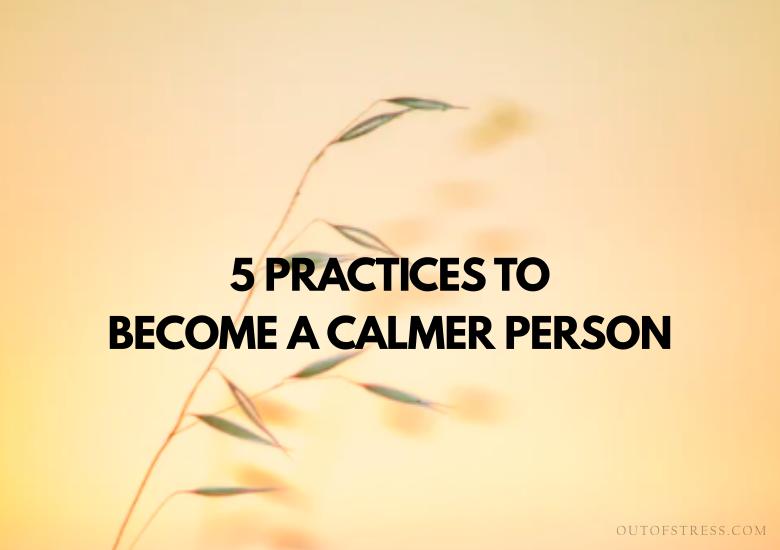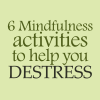“Calmness of mind is one of the beautiful jewels of wisdom. It is the result of long and patient effort in self-control. Its presence is an indication of ripened experience, and of a more than ordinary knowledge of the laws and operations of thought.” – James Allen
Calmness is a powerful virtue. Having a calm head on your shoulders can help you handle stressful situations better, make better decisions and emit an energy field that is powerful and attractive.
Let’s say you are driving and someone honks at you or overtakes you in an unsafe manner; would you rather give into road rage (in which case you would need to engage with this rude person) or would you rather just stay calm and let go? This person will go away and you will probably never meet them again. So why waste your energy on them?
There are some people who want to cause trouble; they want to engage in a fight because it gets them attention. Would you rather engage with such a person or just let go and save your sanity?
That’s the power that being calm affords you.
You develop the power to respond consciously instead of reacting unconsciously/impulsively to external events.
So is there a way to become a calmer person?
Yes there is and in this article, we will look at 5 simple practices that will help you achieve that. Before proceeding, let’s have a quick look at the five life changing benefits that having a calm personality gives you.
5 life changing benefits of being calm
1. It’s good for your health
When you are stressed out, your body switches on the ‘Fight or Flight’ response (the sympathetic nervous system) which shuts down restorative/healing processes. Your muscles tense up, breathing becomes shallow and your blood pressure/heart rate increases. In other words, your body takes a hit.
The issue is that your body cannot differentiate between an actual treat and something non-life threatening like work pressure, traffic jams or family difficulties. So you could live in a constant state of stress which could take a toll on your heath in the long run.
On the other hand, when you are calm and relaxed, your body returns to the parasympathetic nervous system and the focus returns to restorative processes. This means, you sleep better, your digestion improves, your immunity is higher, your thinking is better and you feel more energetic overall as both your mental and physical health improves.
2. Your thinking broadens
When you are stressed, your find it harder to think clearly. Whereas, when you are calm, your thinking broadens. This means you can understand things from a deeper perspective, think out of the box, attract new ideas and make better decisions.
3. You become more creative
Research suggests that when your mind is calm and relaxed, you attract the most creative ideas and also experience the most ‘aha moments’. You are least creative when your mind is stressed and over-worked.
4. You use your energy more efficiently
Energy is a limited resource. When you are calm and collected, you can consciously direct your energy into creative pursuits that give you peace of mind and happiness instead of unconsciously focusing it on things that drain you. This means, you feel more energetic and your overall quality of life improves.
5. You attract positivity into your life
Stress is a state of contraction and calm is a state of expansion. When you are calm, your vibration turns positive and you attract more positivity and abundance into your life.
5 practices to help you become calmer
Now that you know the amazing benefits you can garner from developing the ability to be calm, let’s take a look at 5 practices that will help you achieve this state of calmness.
1. Practice focused meditation
Meditation is the gateway to calmness as it helps you gain better control over your mind and emotions.
Here’s why.
There is a part of your brain known as the ‘Amygdala’ which is your brain’s fear center. It is also the area of the brain that controls emotions. There is also the ‘prefrontal cortex’ which is your conscious brain.
Research indicates that meditation strengths the connection between the ‘prefrontal cortex’ and amygdala allowing you to have better control over your emotions.
Research also indicates that meditation actually shrinks the actual size of the amygdala.
This means, not only will you be able to recover faster from emotional bouts, but you will also become more responsive as opposed to being impulsive and reactive to emotions.
So how do you meditate to attain calmness?
Meditation is simply – ‘learning to focus your attention‘. Based on this, there are two types of meditation that you can do.
- Focused meditation: Where you focus your attention on a fixed target for prolonged periods of time. This helps you gain awareness of your attention.
- Open focus meditation (also known as open monitoring or mindfulness): Where you stay conscious/alert of your attention where ever it gets focused. This is akin to staying in the present moment.
You can start with the practice of focused meditation and when you have better control over your attention, also include mindfulness (open focus meditation) into your practice.
Here’s a simple exercise to get started with focused meditation:
Sit comfortably, close your eyes and direct your attention to your breathing. Feel the sensation of cool air caressing the base of your nostrils as your breathe in and the warm air released as you breathe out. Make sure not to strain yourself and keep relaxing your body while doing this.
If your attention wanders to your thoughts, acknowledge that and gently bring it back to your breath. It is this act of bringing your attention back over and over again that strengthens your focus muscle. This will happen a lot in the beginning and will reduce over time.
Do not try to control your thoughts, let them be. Your only objective is to keep bringing your attention to your breath.
If you feel frustrated at how often your focus goes back to your thoughts, tell yourself that this is normal and happens to everyone. This is just like learning to ride a bicycle. You fall down the first few times but eventually you find balance.
Do this for 3 minutes daily for a week and increase it to 5 minutes and then 10 minutes as you progress.
Also Read: 59 Calming Quotes for Anger.
2. Understand your emotions
Thoughts are to your mind what emotions are to your body. Whenever there is a thought in your mind, depending on the intensity of the thought, a resultant emotion is felt in the body.
Think of emotions as an energy form. When your body gets filled by an emotion, you are essentially getting filled with energy that seeks some form of release and it often results in an unconscious reaction. And an unconscious reaction is generally not very logical.
For example, you might shout at someone and then later regret it thinking it wasn’t the right thing to do and that you could have acted more sanely. In some cases, you could even get into physical altercation, break stuff or other such actions.
So how do you stop your emotions from getting the better of you?
The solution is to stay conscious of your emotions. Here’s how,
Before you react, pause for a few seconds and become conscious of the emotion that is evoking this reaction out of you. Consciously feel the emotion – where do you feel it in your body? How does it feel? What kind of sensations do you feel in your body? How is your body reacting to this emotion? Is your heart beating fast? Are you breathing faster than usual? Are you getting fidgety?
The more conscious you are of your emotions (and the related bodily sensations), the less control they have over you.
One really simple exercise you can do that I personally find extremely useful is to recreate scenarios that caused you to lose your cool and then witness the emotions consciously.
Here’s how you can do this:
Exercise: Sit comfortably, close your eyes and bring to your mind a past scenario that caused you to lose your cool. As you bring this scenario to your mind, your body will start to generate emotions similar to the one you experienced during the event. Take time to consciously feel these emotions. Notice everything – how does your body feel? What sensations arise? Where do they arise?
The idea is to learn to feel the energy behind the emotion. When you feel the energy, you no longer suppress the emotion – instead you are releasing the emotion. Letting it go.
Recreating scenarios this way helps you stay more prepared the next time a similar situation or triggers arise.
3. Connect with your body
As we discussed earlier, your emotions happen in your body. Therefore, getting in touch with your body can help you immensely in understanding your emotions better.
And the best way to get in touch with your body is through the practice of body awareness.
There are various body awareness exercises you can do but here are 3 really powerful ones:
a. Follow your breath: When you breathe, the air outside enters your body. By following this air, you can enter your body too. As you breathe in slowly, feel the air entering your nostrils as it makes its way to your lungs. Feel your lungs inflate. Hold your breath for a few seconds and feel this air in your lungs before you exhale. Repeat for a few times.
b. Feel your heart beating: Close your eyes and direct your attention toward your heart. Feel it beating and pumping life energy to all parts of your body. If you cannot feel at first, you can place a hand over your heart and feel it beat that way.
c. Do a body awareness meditation: In a body awareness meditation, you slowly run your attention throughout your body starting from your toes to the crown of your head. As your attention runs through your body, see if you can feel any sensations – mild aches, tingling, hotness/coolness etc. If you find an ache, stay there for sometime and relax this area. Similarly, if you find a tense/clenched muscle, simply focus your attention there for a few more seconds and the muscle will feel relaxed.
The following is a 3 minute body scan meditation that will help you do right now to understand how this works:
(source)
4. Learn to consciously relax your body
When you are under stress, your body tightens up. Therefore, the ability to consciously relax your body is important in your journey toward calmness.
Exercise: Staying mindful of your body multiple times a day. As you become mindful, quickly scan your body (as we saw in the body awareness meditation above) and see if there are any tense/tight/clenched muscles and relax them.
Personally, I have found that whenever I am working on my computer or whenever I am stressed, I tend to unconsciously clench my stomach, and my upper back muscles mostly my nape (back of neck) and the occipital muscles (muscles in the back of my head). This used to cause me back aches and headaches. I also tend to move my legs a lot (restless leg syndrome). Being mindful and relaxing these muscles helped me overcome all these negative symptoms.
So whenever you feel stressed, find out which muscles in your body feel tight/tense and learn to relax them consciously by letting go.
You can also try doing the PMR (Progressive Muscle Relaxation) exercises as they teach you what a clenched and relaxed muscle feels like. The following video offers a guided PMR exercise:
5. Develop self compassion
The final practice that will help you become more calm is the practice of self compassion.
Let’s say you are running a marathon and you fall down. There is a group on your left that shouts, ‘You are a loser, you should just quit‘. And there is a group on the right that shouts, ‘It’s okay, everyone falls down, you can do it. Get up and run again!‘ Which voice will you listen to? The voice on the left is the voice of your inner critique and the voice on the right is the voice of self compassion.
Self compassion comes through empathy and empathy comes from awareness. The more aware you become of your beliefs/thoughts/emotions, the more self compassionate you will become.
Similarly, the more empathetic you become toward your own self, the more empathy you will have for others. More empathy means it will be easier for you to let go and forgive instead of wanting to engage with someone.
Exercise: Stay mindful of your inner voice (self talk) and see if your voice is critical or uplifting. Learn to look at your thoughts/emotions from an objective perspective. Realize that you are not your thoughts/emotions. Be the awareness that is a witness to thoughts/emotions instead of being one with your thoughts/emotions.
In conclusion
Becoming calmer is an exercise in self awareness. The more aware you become, the more control you gain over your attention, thoughts and behaviors and all of these help you become calmer. The practices in this article are aimed at helping you become more self aware.
As you do these calming practices, you will start seeing success, but there will also be moments when you might lose your cool, but do not let that deter you. These are bound to happen. The important thing is to forgive yourself and use this as a learning experience to understand yourself better.
Also Read: 32 Ways To Relax Before Bedtime (For Deep, Restorative Sleep)








